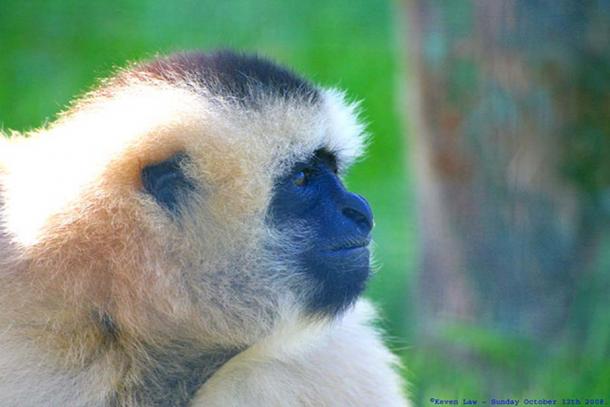
New Gibbon Genus Discovered in Ancient Chinese Royal Tomb?
A gibbon skull recovered from an ancient tomb in China was possibly driven to extinction in the last two millennia and researchers told reporters at Science “it might be an entirely new species.”
In 2004, archaeologists digging near Xi’an in Shaanxi province, central China, discovered a large tomb which dated to between 200 - 300 BC. Then, in 2011, Samuel Turvey, a conservation biologist at the Zoological Society of London studied a collection of leopard, bear and crane skeletons recovered from the tomb and among these was the “skull and jaw of a gibbon.”

The skull of a possible new genus, ‘Junzi imperialis’ was found in an ancient tomb in China. Credit: Samuel Turvey/ZSL
The conservation team, led by Samuel Turvey and Helen Chatterjee, an evolutionary biologist at University College London, speculated that the tomb might belong to Lady Xia, grandmother of Qin Shihuang, China’s first emperor whose mausoleum and body are highly guarded by the 8,000 strong Terracotta Warrior Army only 31 miles (50 kms) to the northeast.
- The Ruthless Chinese Emperor Qin Shi Huang: How He Unified and Tyrannized His Subjects
- How the Search for Immortality Killed the First Emperor of China
- The Wonders and The Terrors of the Qin Dynasty

Qin Shi Huang, first emperor of the Qin Dynasty. (Public Domain)
Chinese traditional folk religion regarded monkeys as supernatural beings and the Chinese symbol specialist Wolfram Eberhard, reported early accounts of monkeys that "could talk", "knew the past", and "were like men.” The earliest monkey-shaped objects ever discovered in China, according to Thomas Geissmann, an expert in gibbon paintings in China, Japan and Korea, were belt hooks from the late Eastern Zhou period (4th-3rd centuries BC) which depict “a gibbon with outstretched arms and hook-shaped hands.” Geissmann (2008)

Gibbons at play, Xuande era (1427) (Public Domain)
Chinese authorities did not permit Turvey and his team to take a DNA sample from the gibbon bone, which hindered them from determining which species the gibbon belonged to. The experts went ‘old school’ and “measured key points on the skull and teeth and compared the dimensions with those of the four living genera of gibbons,” according to Science. An article in Nature described the scientists’ findings; “the braincase is much larger, and the cheekbones narrower, than those of any of the four known living genera of gibbon.” Furthermore, they also found that “the molars of the ancient gibbon are distinct, too, with grinding surfaces bigger than those of most gibbons, yet smaller than those of siamangs.”
- Primates of Ancient Egypt: The Deification and Importance of Baboons and Monkeys—Part I
- Primates of Ancient Egypt: The Bizarre and Satirical Monkeys of Amarna—Part II
- The Sky, the Sun & the King: Mischievous and Divine Monkeys in Asian Myth

White Cheeked Gibbon - Rare Species Centre, Kent, England (CC BY-SA 2.0)
Chatterjee believes these differences “are significant enough, we argue, to warrant a new genus and species.” Thomas Geissmann, a gibbon expert at the University of Zurich in Switzerland, told reporters at Sciencemag, “The skull is really a fantastic find… I don't doubt for a second that it's a new species, and probably a new genus.” The scientists named the gibbon skeleton Junzi imperialis, which translates to ‘imperial man of virtue or noble character’ - a wink to the gibbons sacred stature in ancient China.
Other researchers are not so convinced that this gibbon deserves to be put into a new genus. Terry Harrison, a biological anthropologist at New York University, said “a new gibbon would be of immense importance,” but he suggests that “animals reared in captivity often have bone problems and experience abnormal growth” which might “account for all of the facial differences that the authors indicate as distinctive.” In response to Harrison, Turvey is open to the possibility that the gibbon was a captive animal, but he told Science reporters “it could equally have been a wild animal that was killed for the tomb menagerie.”

Two Gibbons in an Oak Tree. (Public Domain)
Assuming for a second that this is a new species of gibbon, that went extinct in the last two thousand years, then how did this happen? Chatterjee theorized that if J. imperialis was native to China its extinction was “related to environmental pressures caused by humans” who expanded rapidly in China over the past two millennia. Paul Garber, an anthropologist at the University of Illinois in Urbana-Champaign, said, “Evidence that a Chinese gibbon species has been driven to global extinction in the past two millennia would be important for highlighting the conservation issues that China faces today.” This, in my opinion is a gross understatement. If a gibbon went extinct in the last 2000 years, it highlights the conservation issues that WE ALL face today.
Did you know? Paul Magee Berry is the executive director of Brother Wolf Animal Rescue [BWAR], a highly-active group who maintain that “global animal agriculture is the number one cause of global deforestation, rainforest depletion, and climate change.” Berry told reporters in October 2017 that "as of this year, we’ve already lost up to 70 percent of the world’s wildlife population since 1970, and that we’re on track to lose 90 percent of the world’s wildlife by 2025.” According to Berry this extinction crisis is what scientists are calling the 'Sixth Mass Extinction of Species on Earth’.
That’s less than ten years from now folks, so it appears that ‘ancient Chinese gibbon’ that we probably saw off, might be the least of our worries.
Top image: Gibbon skull found in China (Credit: Samuel Turvey/ZSL); Luohan, hanging scroll, ink and color on silk (Public Domain); Apes and Horses (Public Domain)
By Ashley Cowie
References
Eberhard, Wolfram (2003 [1986 (German version 1983)]), A Dictionary of Chinese Symbols: Hidden Symbols in Chinese Life and Thought, Routledge.
Geissmann, Thomas (2008), "Gibbon paintings in China, Japan, and Korea: Historical distribution, production rate and context", Gibbon Journal, 4:1-38.















